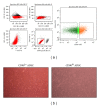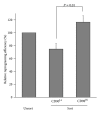CD90- (Thy-1-) high selection enhances reprogramming capacity of murine adipose-derived mesenchymal stem cells
- PMID: 24282338
- PMCID: PMC3824355
- DOI: 10.1155/2013/392578
CD90- (Thy-1-) high selection enhances reprogramming capacity of murine adipose-derived mesenchymal stem cells
Abstract
Background: Mesenchymal stem cells (MSCs), including adipose tissue-derived mesenchymal stem cells (ADSC), are multipotent and can differentiate into various cell types possessing unique immunomodulatory features. Several clinical trials have demonstrated the safety and possible efficacy of MSCs in organ transplantation. Thus, stem cell therapy is promising for tolerance induction. In this study, we assessed the reprogramming capacity of murine ADSCs and found that CD90 (Thy-1), originally discovered as a thymocyte antigen, could be a useful marker for cell therapy.
Method: Murine ADSCs were isolated from B6 mice, sorted using a FACSAria cell sorter by selection of CD90(Hi) or CD90(Lo), and then transduced with four standard factors (4F; Oct4, Sox2, Klf4, and c-Myc).
Results: Unsorted, CD90(Hi)-sorted, and CD90(Lo)-sorted murine ADSCs were reprogrammed using standard 4F transduction. CD90(Hi) ADSCs showed increased numbers of alkaline phosphatase-positive colonies compared with CD90(Lo) ADSCs. The relative reprogramming efficiencies of unsorted, CD90(Hi)-sorted, and CD90(Lo)-sorted ADSCs were 100%, 116.5%, and 74.7%, respectively. CD90(Hi) cells were more responsive to reprogramming.
Conclusion: CD90(Hi) ADSCs had greater reprogramming capacity than CD90(Lo) ADSCs, suggesting that ADSCs have heterogeneous subpopulations. Thus, CD90(Hi) selection presents an effective strategy to isolate a highly suppressive subpopulation for stem cell-based tolerance induction therapy.
Figures







References
-
- Takahashi K, Yamanaka S. Induction of pluripotent stem cells from mouse embryonic and adult fibroblast cultures by defined factors. Cell. 2006;126(4):663–676. - PubMed
-
- Le Blanc K, Mougiakakos D. Multipotent mesenchymal stromal cells and the innate immune system. Nature Reviews Immunology. 2012;12(5):383–396. - PubMed
MeSH terms
Substances
LinkOut - more resources
Full Text Sources
Other Literature Sources
Miscellaneous

